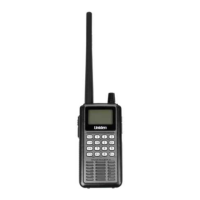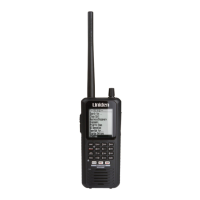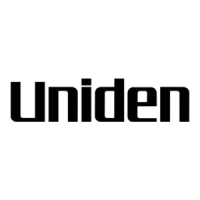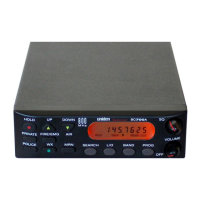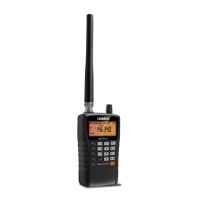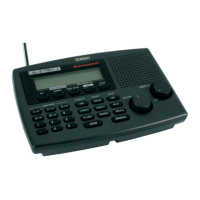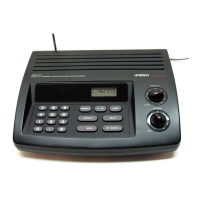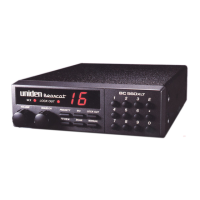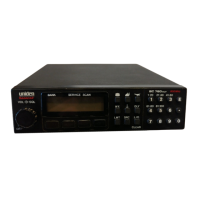Do you have a question about the Uniden BCD325P2 and is the answer not in the manual?
Warning about using incorrect earphones with the scanner to prevent hearing damage.
Warning that the unit is not waterproof and should not be exposed to rain or moisture.
Scanner complies with FCC rules; legal aspects of scanning and modification notices.
Explains memory organization, simplex, repeater, and trunking systems.
Explains CTCSS/DCS/NAC codes for interference prevention.
Covers items in the box and initial setup like antenna and batteries.
Instructions for USB connection and initial scanner power-up and squelch settings.
Guide to using the scanner's menu system for configuration and operation.
Describes the physical layout of buttons and the main control knob.
Details functions of scroll control, SQL, Vol, and Menu keys in various modes.
Explains the primary operations of the Func, Hold, and Scan/Srch keys.
Describes the L/O and Power/Backlight keys for managing lockout status and display.
Explains the use of number keys for input, navigation, and quick access.
Shows and explains display information for conventional systems.
Shows and explains display information for trunking systems.
Explains indicators on the top and second lines of the scanner display.
Details information shown on the third and fourth lines of the display.
Introduces the menu structure for accessing various settings.
Covers adjusting key beep, display contrast, and control channel output.
Explains how to configure GPS formats, baud rates, and default band settings.
Covers P25 LP Filter, Threshold, and Unit ID display options.
Covers keypad lockout, battery level, cloning, and scanner reset.
Guidance on organizing scanner data, number tags, and alerts.
Step-by-step guide to creating and configuring conventional radio systems.
How to assign quick keys, startup keys, and number tags to systems.
Covers hold time, delay time, AGC, and P25 waiting time for systems.
Instructions for setting up different types of trunked radio systems.
Covers number tags, ID scan/search, delay time, and fleetmap editing.
Covers priority ID scan, status bits, end codes, and emergency alerts.
Covers setting ID format and audio AGC for trunked systems.
Steps to create and configure sites within trunked systems.
Covers naming sites, quick keys, startup keys, and band plans.
How to set site types (EDACS) and program/edit frequencies.
Settings for site-specific modulation, attenuation, lockout, and scan hold time.
How to set location-based scanning and P25 waiting time for sites.
Covers naming groups, setting quick keys, editing channels, and location info.
How to set lockout status for groups.
How to quickly store frequencies into groups.
How to quickly store talkgroup IDs into groups.
How to set options for individual channels.
How to name channels and edit their frequencies or IDs.
How to set audio type, modulation, and attenuator for channels.
How to set priority, alerts, lockout, and volume offset for channels.
How to adjust volume offset and copy/paste channel settings.
How to use a GPS unit for automatic site/group locking/unlocking.
How to program location-based alerts like POIs and dangerous roads.
How to program and edit location information (name, type).
How to configure alerts (tone, volume, light) for POIs and dangerous locations.
How to view GPS data and manage location lockout status.
How to review and manage programmed location data.
Explains different priority scanning methods.
How to manage frequency lockouts and broadcast screening.
How to select search types and program custom bands.
Covers repeater find, auto store limits, and search delay times.
How to configure attenuator and AGC for search operations.
Steps to edit preprogrammed service search ranges.
How to automatically store found frequencies or IDs.
How to select bands and configure alerts for Close Call hits.
How to set Close Call modes and enable automatic storage of hits.
How to scan weather channels and set alert priority.
How to program FIPS codes for county-specific weather alerts.
Configuration options for weather operations.
How to configure Tone-Out monitoring for specific channels.
Tables showing preset fleet map configurations.
Covers size, weight, operating temperatures, and power requirements.
Details scanner sensitivity across various frequency bands.
Nominal Hum & Noise and Close Call sensitivity figures.
Information on battery recycling programs.
Details the warranty period and what is covered.
Lists conditions that void the warranty and available remedies.
Instructions for obtaining warranty service for the product.
Warning about using incorrect earphones with the scanner to prevent hearing damage.
Warning that the unit is not waterproof and should not be exposed to rain or moisture.
Scanner complies with FCC rules; legal aspects of scanning and modification notices.
Explains memory organization, simplex, repeater, and trunking systems.
Explains CTCSS/DCS/NAC codes for interference prevention.
Covers items in the box and initial setup like antenna and batteries.
Instructions for USB connection and initial scanner power-up and squelch settings.
Guide to using the scanner's menu system for configuration and operation.
Describes the physical layout of buttons and the main control knob.
Details functions of scroll control, SQL, Vol, and Menu keys in various modes.
Explains the primary operations of the Func, Hold, and Scan/Srch keys.
Describes the L/O and Power/Backlight keys for managing lockout status and display.
Explains the use of number keys for input, navigation, and quick access.
Shows and explains display information for conventional systems.
Shows and explains display information for trunking systems.
Explains indicators on the top and second lines of the scanner display.
Details information shown on the third and fourth lines of the display.
Introduces the menu structure for accessing various settings.
Covers adjusting key beep, display contrast, and control channel output.
Explains how to configure GPS formats, baud rates, and default band settings.
Covers P25 LP Filter, Threshold, and Unit ID display options.
Covers keypad lockout, battery level, cloning, and scanner reset.
Guidance on organizing scanner data, number tags, and alerts.
Step-by-step guide to creating and configuring conventional radio systems.
How to assign quick keys, startup keys, and number tags to systems.
Covers hold time, delay time, AGC, and P25 waiting time for systems.
Instructions for setting up different types of trunked radio systems.
Covers number tags, ID scan/search, delay time, and fleetmap editing.
Covers priority ID scan, status bits, end codes, and emergency alerts.
Covers setting ID format and audio AGC for trunked systems.
Steps to create and configure sites within trunked systems.
Covers naming sites, quick keys, startup keys, and band plans.
How to set site types (EDACS) and program/edit frequencies.
Settings for site-specific modulation, attenuation, lockout, and scan hold time.
How to set location-based scanning and P25 waiting time for sites.
Covers naming groups, setting quick keys, editing channels, and location info.
How to set lockout status for groups.
How to quickly store frequencies into groups.
How to quickly store talkgroup IDs into groups.
How to set options for individual channels.
How to name channels and edit their frequencies or IDs.
How to set audio type, modulation, and attenuator for channels.
How to set priority, alerts, lockout, and volume offset for channels.
How to adjust volume offset and copy/paste channel settings.
How to use a GPS unit for automatic site/group locking/unlocking.
How to program location-based alerts like POIs and dangerous roads.
How to program and edit location information (name, type).
How to configure alerts (tone, volume, light) for POIs and dangerous locations.
How to view GPS data and manage location lockout status.
How to review and manage programmed location data.
Explains different priority scanning methods.
How to manage frequency lockouts and broadcast screening.
How to select search types and program custom bands.
Covers repeater find, auto store limits, and search delay times.
How to configure attenuator and AGC for search operations.
Steps to edit preprogrammed service search ranges.
How to automatically store found frequencies or IDs.
How to select bands and configure alerts for Close Call hits.
How to set Close Call modes and enable automatic storage of hits.
How to scan weather channels and set alert priority.
How to program FIPS codes for county-specific weather alerts.
Configuration options for weather operations.
How to configure Tone-Out monitoring for specific channels.
Tables showing preset fleet map configurations.
Covers size, weight, operating temperatures, and power requirements.
Details scanner sensitivity across various frequency bands.
Nominal Hum & Noise and Close Call sensitivity figures.
Information on battery recycling programs.
Details the warranty period and what is covered.
Lists conditions that void the warranty and available remedies.
Instructions for obtaining warranty service for the product.
| Type | Handheld Scanner |
|---|---|
| Channels | 25, 000 |
| Close Call RF Capture | Yes |
| GPS Compatible | Yes |
| Modulation Types | AM, FM, NFM, WFM |
| PC Programmable | Yes |
| Memory Backup | Yes |
| Trunking Systems | Motorola, EDACS, LTR |
| Display | LCD |
| Bands | VHF, UHF |
| Digital Modes | APCO 25 Phase I |
| Battery Life | Varies with usage |
